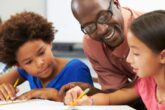
And just like that, 2022 is almost behind us. We’re sure it’s been another busy year – it certainly has for us at the Pearson International Schools blog! Did you have time to catch all of our articles? In case you missed them, here are our top ten posts of the year for some reading over the holidays.
1. Mastery of learning: what is it and how to implement it?
Mastery of learning is something that all humans do instinctively from birth. All students must master key concepts before moving on to the next topic, but the depth and pace of mastery can vary from student to student. How can it be applied as an effective strategy in the classroom, and what are the benefits?
Read more about mastery of learning and how to implement it.
2. Should schools have a four-day week?
Within the world of business, the four-day work week has been shown to make a positive difference to people’s emotional wellbeing and work-life balance. What impact would it have on teachers and students? This article takes a look at some case studies and opens up the debate.
Discover the pros and cons of a four-day week for schools.
3. The big debate: should school holidays be shortened?
Another topic that’s been up for debate is the length of summer holidays. This article takes a look at how school holidays work around the world. It goes into the benefits and drawbacks of a long summer holiday.
Read more about the big debate: should school holidays be shortened?
4. How the Pomodoro technique can help improve student focus
You may have heard of the Pomodoro technique – a simple way to improve your productivity and concentration. It consists of focusing for a set amount of time with no distractions and then taking a break. When and how could you adapt it to your classroom to help students make the most of their time?
Learn how the Pomodoro technique can help improve student focus.
5. How to equip students with seven skills they’ll need for university
Making the move from school to university is a big transition for lots of teenagers. Read this article for tips on how to teach your students the skills they’ll need to succeed in higher education.
Find out how to equip students with seven skills they’ll need for university.
6. Why it’s important to practise active listening with your students
Teachers need to be constantly aware in class, often thinking ahead to what’s next while supervising, answering questions and offering support. But learning to be present and attentive is an important skill too. Find out how to master the art of active listening to transform your relationships with your students.
Learn more about why it’s important to practise active listening with your students.
7. Five ways to create a stimulating classroom environment
This article looks at how to design a stimulating and welcoming classroom environment, without distracting students from learning. Flexibility, lighting, colour, wall displays and nature are five important factors to consider.
Discover our tips on how to create a stimulating classroom environment.
8. Supporting a successful transition from MYP to DP mathematics – assessed curriculum
The final article of this five-part series discusses how the detailed consideration of assessment objectives and the carefully planned development of approaches to learning (ATL) skills can support the Middle Years Programme (MYP) to Diploma Programme (DP) transition.
Read more about supporting a successful transition from MYP to DP mathematics – assessed curriculum.
9. How to talk about gender and pronouns in your classroom
With the growing awareness of the gender spectrum, this article looks at how we can talk about gender and pronouns. It shows how to broach the topic with our students in an informed, sensitive and inclusive way – and why it’s important.
Find out how to talk about gender and pronouns in your classroom.
10. Place-based learning: helping students to connect to their community
Place-based learning can be described as a teaching and learning method which focuses on students’ local environment, history, culture and community. Find out more about place-based learning and its benefits in this article.
Learn how place-based learning can help students to connect to their community.
Subscribe to our blog
If you’d like to stay up to date with our articles in 2023, why not subscribe to our blog? You’ll get a fortnightly roundup of the articles you’ve missed straight to your inbox, plus links to free teaching resources.
We hope you enjoy a well deserved break, and we’ll see you in 2023 with your batteries recharged!

